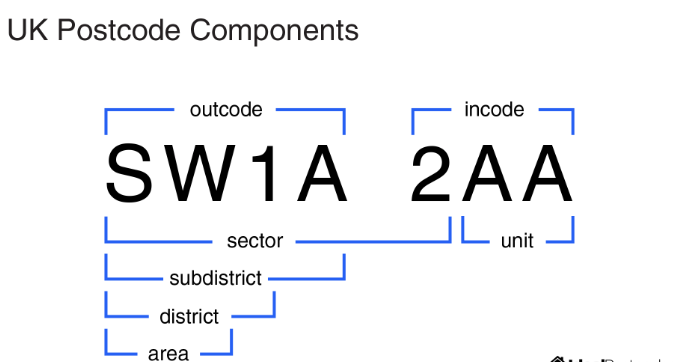The uk zip code is a marvel of logistical engineering. More than just a random string of letters and numbers, it’s a hierarchical addressing system that can pinpoint a single building or a small group of properties. Understanding its structure is key to understanding how mail and services are efficiently delivered across the nation.
The Correct Terminology: Postcode, Not ZIP Code
First, a crucial point of terminology. In the United Kingdom, the correct term is “Postcode.” The term “ZIP code” is specific to the United States Postal Service (USPS). While the function is similar, the systems are entirely different.
The Anatomy of a uk zip code
A UK postcode is alphanumeric and follows a consistent, two-part structure: the Outward Code and the Inward Code, separated by a single space.
Format: [Outward Code] [Inward Code]
Let’s break down each part.
1. The Outward Code (Postcode Area and District)
The Outward Code is the part before the space. It directs mail to the general area or local sorting office.
-
Postcode Area (1-2 characters): This is the broadest geographical identifier, representing a major city or a large region. It is always one or two letters.
-
Examples:
-
SWfor South West London -
Bfor Birmingham -
EHfor Edinburgh (remember, Scotland has its own prefixes) -
BTfor Belfast (Northern Ireland)
-
-
-
Postcode District (1-2 numbers, sometimes with a following letter): This narrows down the area to a specific town, district, or part of a city. The number is added to the Area code, and some large districts add a final letter for further precision.
-
Examples:
-
SW1A– The ‘1A’ district within the SW area (famous for containing 10 Downing Street). -
B1– The central district of Birmingham. -
EH12– A district in West Edinburgh. -
BT15– A district in North Belfast.
-
-
2. The Inward Code (Postcode Sector and Unit)
The Inward Code follows the space and provides the final, precise level of sorting, directing the mail to a specific street or even a single address.
-
Postcode Sector (1 number): This is the first character of the Inward Code. It subdivides a district into smaller geographic areas, often corresponding to a particular village, a large housing estate, or a group of streets.
-
Example: In
SW1A 2, the2is the sector.
-
-
Postcode Unit (2 letters): These final two letters are the most precise part of the code. They identify a very small group of properties—often between 1 and 80 addresses. This could be a single building, one side of a street, or a single business premises.
-
Example: In
SW1A 2AA, theAAis the unit. This specific code is for the Houses of Parliament.
-
Putting It All Together: SW1A 2AA
-
Outward Code:
SW1A-
Area:
SW(South West London) -
District:
1A(A specific part of central SW London)
-
-
Inward Code:
2AA-
Sector:
2(A specific area within the SW1A district) -
Unit:
AA(The specific building group for the Houses of Parliament) - CSV Download full list of UK outward codes.
-
Key Characteristics and Intricacies
-
Not All Are Created Equal: The granularity of a postcode varies. A rural postcode might cover a dozen farms spread over a wide area, while a city centre postcode could refer to a single large office building or even a single business (e.g., the iconic
W1A 1AAfor BBC Broadcasting House). -
Non-Geographic Postcodes: Some postcodes are not tied to a geographic location but to a specific organisation receiving vast amounts of mail.
-
The Girobank:
GIR 0AAwas the classic example. -
The DVLA (Driver and Vehicle Licensing Agency): Uses
SA99for all its correspondence. -
BFPO (British Forces Post Office): Uses codes like
BF1 3AXto route mail to British military bases overseas.
-
-
Special Postcodes: Some are famous in their own right.
-
SW1A 0AA– The Palace of Westminster (Houses of Parliament) -
SW1A 1AA– 10 Downing Street (The Prime Minister’s residence) -
SW1A 2AA– Buckingham Palace -
N1 9GU– The Guardian newspaper’s office (a playful reference to its name) - CSV Download full list of UK postcode units.
-
-
Formatting is Key: The space is crucial. Omitting it or misplacing it can cause errors in automated sorting systems. The correct format is always
[AA9A 9AA]or[A9A 9AA]or[A9 9AA]or[A99 9AA]etc.
How to Write a UK Address with a Postcode
A properly formatted UK address uses the postcode as the final line, capitalised and with the space in the correct place. This is the format recommended by the Royal Mail.
Example:
Mr John Smith 123 Maple Avenue LONDON SW1A 1AA
Key points:
-
The postcode is on a line of its own.
-
The post town (e.g., LONDON) is written in block capitals.
-
The postcode is also in block capitals.
The Purpose and Power of Postcodes
Beyond delivering mail, postcodes are integral to modern life in the UK:
-
Logistics and Navigation: Essential for courier services, sat-nav systems, and online food delivery.
-
Insurance and Finance: Used to calculate risk and premiums (e.g., car insurance is heavily influenced by your postcode).
-
Demographics and Marketing: Companies use postcode data for market research, store location planning, and targeted advertising.
-
Online Services: Virtually every e-commerce website requires a postcode to calculate shipping costs, check delivery eligibility, and auto-fill addresses.
Finding a Postcode
The official source for all Uk zip code is the Royal Mail’s Postcode Finder, available on their website. Other services like Google Maps or auto-complete functions on shopping websites also use licensed versions of this data.
Key Patterns
UK postcodes can assume one of the following patterns:
| Postcode Format | Outward Code | Inward Code | Postcode Area | District Code | Sub-District | Sector | Unit |
|---|---|---|---|---|---|---|---|
AA9A 9AA |
AA9A |
9AA |
AA |
AA9 |
AA9A |
AA9A 9 |
AA |
A9A 9AA |
A9A |
9AA |
A |
A9 |
A9A |
A9A 9 |
AA |
A9 9AA |
A9 |
9AA |
A |
A9 |
N/A | A9 9 |
AA |
A99 9AA |
A99 |
9AA |
A |
A99 |
N/A | A99 9 |
AA |
AA9 9AA |
AA9 |
9AA |
AA |
AA9 |
N/A | AA9 9 |
AA |
AA99 9AA |
AA99 |
9AA |
AA |
AA99 |
N/A | AA99 9 |
AA |
Summary
The UK postcode is a sophisticated, hierarchical system that moves from the general (Area) to the highly specific (Unit). It is a critical piece of national infrastructure that powers not just the postal service but a vast array of commercial and social activities. Remember: it’s a Postcode, write it with a space, and you hold the key to finding almost any address in the country.



